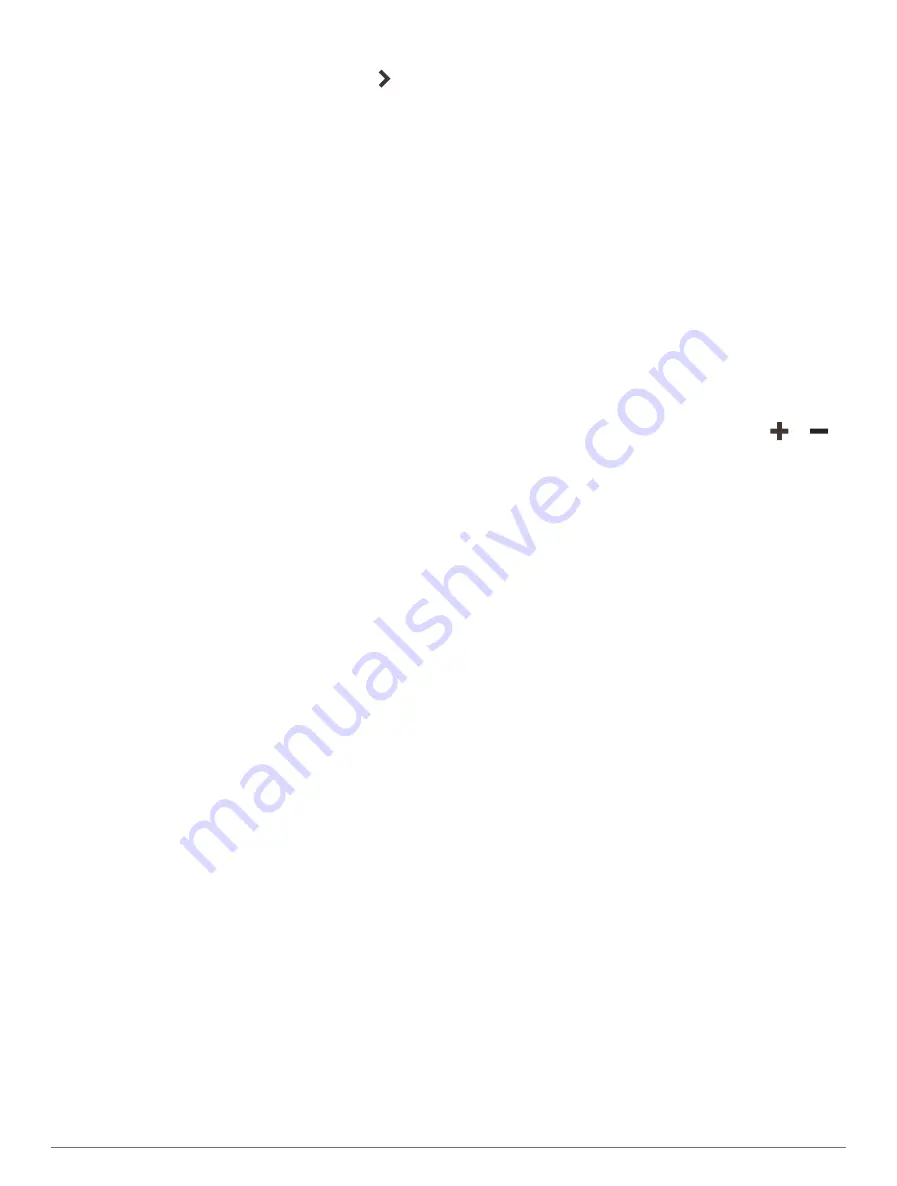
Setting the Zoom Level on the Sonar Screen
1
From a sonar view, select
Options
>
Zoom
> >
Mode
.
2
Select an option:
• To set the depth and zoom automatically, select
Auto
.
If necessary, select
Set Zoom
to modify the zoom
setting. Select
View Up
or
View Down
to set
the depth range of the magnified area, and select
Zoom In
or
Zoom Out
to increase or decrease the
magnification of the magnified area.
• To set the depth range of the magnified area
manually, select
Manual
.
If necessary, select
Set Zoom
to modify the zoom
setting. Select
View Up
or
View Down
to set
the depth range of the magnified area, and select
Zoom In
or
Zoom Out
to increase or decrease the
magnification of the magnified area.
• To magnify one particular area of the screen, select
Magnify
.
If necessary, select
Magnify
to increase or
decrease the magnification level.
TIP:
You can drag the magnification box to a new
location on the screen.
• To zoom in on the sonar data from the bottom
depth, select
Bottom Lock
.
If necessary, select
Span
to adjust the depth and
placement of the bottom lock area.
To cancel the zoom, deselect the Zoom option.
Setting the Scroll Speed
You can set the rate at which the sonar image moves
across the screen. A higher scroll speed shows more
detail until there is no additional detail to show, at which
point it starts stretching out the existing detail. This can
be useful while moving or trolling, or when you are in
very deep water where the sonar is pinging very slowly.
A lower scroll speed displays sonar information on the
screen longer.
For most situations, the Default setting provides a good
balance between a quickly scrolling image and less
distorted targets.
1
From a sonar view, select
Options
>
Sonar Setup
>
Scroll Speed
.
2
Select an option:
• To adjust the scroll speed automatically using
speed-over-ground or water speed data, select
Auto
.
The
Auto
setting selects a scroll rate to match the
boat speed, so targets in the water are drawn with
the correct aspect ratio and appear less distorted.
When viewing Garmin ClearVü/SideVü sonar views
or searching for structure, it is recommend to use
the
Auto
setting.
• To scroll faster, select
Up
.
• To scroll more slowly, select
Down
.
Adjusting the Range
You can adjust the range of the depth scale for traditional
and Garmin ClearVü sonar views. You can adjust the
range of the width scale for the SideVü sonar view.
Allowing the device to adjust the range automatically
keeps the bottom within the lower or outer third of the
sonar screen, and can be useful for tracking a bottom that
has minimal or moderate terrain changes.
Manually adjusting the range enables you to view a
specified range, which can be useful for tracking a bottom
that has large terrain changes, such as a drop-offs or
cliffs. The bottom can appear on the screen as long as it
appears within the range you have set.
1
From a sonar view, select
Options
>
Range
.
2
Select an option:
• To allow the chartplotter to adjust the range
automatically, select
Auto
.
• To increase or decrease the range manually, select
Up
or
Down
.
TIP:
From the sonar screen, you can select
or
to
manually adjust the range.
TIP:
When viewing multiple sonar screens, you can
select Select to choose the active screen.
Sonar Noise Rejection Settings
From a sonar view, select
Options
>
Sonar Setup
>
Noise Reject
.
Interference
: Adjusts the sensitivity to reduce the effects
of interference from nearby sources of noise.
The lowest interference setting that achieves the
desired improvement should be used to remove
interference from the screen. Correcting installation
issues that cause noise is the best way to eliminate
interference.
Color Limit
: Hides part of the color palette to help
eliminate fields of weak clutter.
By setting the color limit to the color of the undesired
returns, you can eliminate the display of undesired
returns on the screen.
Smoothing
: Removes noise that is not part of a normal
sonar return, and adjusts the appearance of returns,
such as the bottom.
When smoothing is set to high, more of the low-
level noise remains than when using the interference
control, but the noise is more subdued because
of averaging. Smoothing can remove speckle from
the bottom. Smoothing and interference work well
together to eliminate low-level noise. You can adjust
the interference and smoothing settings incrementally
to remove undesirable noise from the display.
Surface Noise
: Hides surface noise to help reduce clutter.
Wider beam widths (lower frequencies) can show more
targets, but can generate more surface noise.
TVG
: Adjusts the time varying gain, which can reduce
noise.
Sonar Fishfinder
43






























